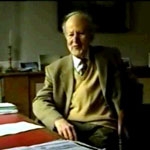Nobel Prize in 1962 for studies of the structures of globular proteins
-
Videos
- Video Interviews with Scientists
- Nobel Prize Video Interviews
- Issues of Concern
- Science Video Lectures
- Reflections on Science Videos
- Masterclass Science Videos
- Science Career Videos
- Lindau 2003 Documentary
- The Next Big Thing Science Videos
- Science Video Research Projects
- Educational Resources
- Documentaries
- Art & Science Videos
- STFC Video Portal
- Women in Science
- You are here >
- Home
- Programmes
- Nobel Prize Video Interviews
- Max Perutz - Science Video Interview
Max Perutz discovered the structure of Haemoglobin (Nobel Prize 1962), and was the founder of the Laboratory for Molecular Biology in Cambridge, the birthplace of modern molecular biology.
Max Perutz died on Wed 6th Feb 2002. The Trust recorded some 8 hours of interviews with Max during 2001 and the short extracts streaming from this site have been edited from this detailed archive. The extracts highlight not only Max`s scientific achievements but also his approach to science. Max had immeasurable influence on UK science through his role as chief architect of the MRC Laboratory for Molecular Biology (LMB) in Cambridge.
| The Haemoglobin story (11 mins) |
The LMB is unquestionably the outstanding scientific research centre worldwide and its amazing success is due in no small measure to the philosophy and attitude that Max fostered. He created an environment in which the creative abilities of a disparate group of highly talented individuals could flourish.
Furthermore - and as important as his academic achievements - these recordings reveal a man of warmth, wit and humanity who epitomised all that is best in science as he worked to ensure that science benefited mankind. We at the Vega Science Trust deem it a privilege to have met him, felt his delight in his friendship and in particular to have been able to construct this intimate portrait one of the world`s great scientists and human beings.
Max Perutz was born in Vienna in 1914. In 1936 he became a research student at the Cavendish Laboratory in a crystallography group directed by J. Bernal and has remained in Cambridge ever since.
In 1953 Perutz showed that the diffracted rays from protein crystals could be phased by comparing the patterns from crystals of the protein with and without heavy atoms attached. In 1959 he determined the structure of haemoglobin using this method, and in 1962 received the Nobel prize. He established the Laboratory of Molecular Biology in 1962 and was chairman until 1979. He remained active in research to the end of his life.
These sections are edited from an extensive archive recording.
Links To Other Information:1962 Nobel Prize
Biography and Details of Max`s Nobel PrizeThe LMB
Max`s lab (home and research) Introduction
to proteins and haemoglobinTechnical
introduction to Haemoglobin








